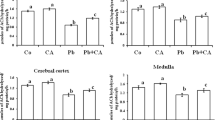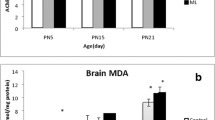Abstract
Lead intoxication affects the central nervous system and produces structural disorders and behavioral deficits in several animal species. Although lead neurotoxicity is a well-reported phenomenon, studies on the developmental neurotoxicity induced by this metal in avian are scarce. The aim of this study was to evaluate how a single dose of 28 μg lead acetate administered into the yolk sac on the fifth incubation day of Gallus domesticus can affect the behavior and the brain tissue in the first postnatal week. Several behavioral tests, mainly those related to the motor and exploratory functions were evaluated at fifth and sixth postnatal days (PN). The lead deposition into mesencephalon and cerebellum was investigated by autometallography (AMG) method. Congenital anomalies, as failure on closure of body’s ventral midline and leg dysfunction, were observed in treated chicks. During the first postnatal week, inactivity and anomalous movements were significantly high in lead treated chicks in comparison to control animals. Lead impregnation was observed in both mesencephalon and cerebellum and the cerebellar molecular layer presented higher lead deposition in comparison to granular layer and Purkinje cells. Our results indicate that the in ovo exposure to lead induces important deficits on motor behavior of chicks during the first postnatal week and such phenomena are related to lead deposition in the cerebellar tissue during embryonic development. The proposed exposure schedule represents an interesting experimental approach for studding behavioral and cellular mechanisms related to lead-induced developmental neurotoxicity.





Similar content being viewed by others
References
Adhami M, Husain R, Seth PK (1996) Influence of iron and lead treatment on behavior and cerebellar and hippocampal polyamine levels in neonatal rats. Neurochem Res 21(8):915–922
Alfano DP, Petit TL (1981) Behavioral effects of postnatal lead exposure. Possible relationship to hippocampal dysfunction. Behav Neural Biol 32:319–333
Al-Saleh IAS (1994) The biochemical and clinical consequences of lead poisoning. Med Res Rev 14:415–486
Antonio MT, Leret ML (2000) Study of the neurochemical alterations produced in discrete brain areas by perinatal low-level lead exposure. Life Sci 67:635–642
Anwer J, Ali S, Mehotra NK (1988) Antagonistic effect of zinc in lead treated developing chick embryos. Drug Chem Toxicol 11(1):85–95
ATSDR (2005) Draft toxicological profile for lead. Agency for toxic substances and disease registry. US Public Health Service, Atlanta
Bortolazzi AA, Duffard RO, Duffard AME (1999) Behavioral alterations induced in rats by a pre- and postnatal exposure to 2,4-dichlorophenoxyacetic acid. Neurotoxicol Teratol 21(4):451–465
Bressler JP, Goldstein GW (1991) Mechanisms of lead neurotoxicity. Biochem Pharmacol 41:479–484
Burger J, Gochfeld M (1995) Effects of varying temporal exposure to lead on behavioral development in herring gull (Larus argentatus) chicks. Pharmacol Biochem Behav 52(3):601–608
Burger J, Gochfeld M (2000) Effects of lead on birds (Laridae): a review of laboratory and the field studies. J Toxicol Environ Health 3:59–78
Burger J, Gochfeld M (2005) Effects of lead on learning in herring gulls: an avian wildlife model for neurobehavioral deficits. Neurotoxicology 26:615–624
Correa M, Roig-Navarro AF, Aragon CMG (2004) Motor behavior and brain enzymatic changes after acute lead intoxication on different strains of mice. Life Sci 74(16):2009–2021
Danscher G (1984) Autometallography. A new technique for light and electron microscopic visualization of metals in biological tissue (gold, silver, metal sulphides and metal selenides). Histochemistry 81:331–335
Dearth RK, Hiney JK, Srivastava V, Burdick SB, Bratton GR, Dees WL (2002) Effects of lead (Pb) exposure during gestation and lactation on female pubertal development in the rat. Reprod Toxicol 16:343–352
Finkelstein Y, Markowitz ME, Roseu JF (1998) Low-level lead-induced neurotoxicity in children: an update on central nervous system effects. Brain Res Rev 27:168–176
Fraser S, Muckle G, Després C (2006) The relationship between lead exposure, motor function and behaviour in Inuit preschool children. Neurotoxicol Teratol 28:18–27
Hamburger V, Hamilton H (1951) A series of normal stages in the development of the chick embryo. J Morphol 88:49–92
Johnston MV, Goldstein GW (1988) Selective vulnerability of the developing brain to lead. Curr Opin Neurol 11(6):689–693
Krause ET, Naguib M, Trillmich F, Schrader L (2006) The effects of short-term enrichment on learning in chickens from a laying strain (Gallus gallus domesticus). Appl Anim Behav Sci 101(3–4):318–327
Lee J, Chen S, Golemboski KA, Parsons PJ, Dietert R (2001) Developmental windows of differential lead-induced immunotoxicity in chickens. Toxicology 156:161–170
Luthman J, Oskarsson A, Olson L, Hoffer B (1992) Postnatal lead exposure affects motor skills and exploratory behavior in rats. Environ Res 58:236–252
Reddy GR, Basha MR, Devi CB, Suresh A, Baker JL, Shafeek A, Heinz J, Chetty CS (2003) Lead induced effects on acetylcholinesterase activity in cerebellum and hippocampus of developing rat. Int J Dev Neurosci 21(6):347–352
Risau W, Wolburg H (1990) Development of the blood–brain barrier. Trends Neurosci 13:174–178
Rivero LBD, Schatz JC, Carvalho MSL, Carvalho MC, Müller YMR (2006) Ação do acetato de chumbo sobre o padrão de desenvolvimento de embriões de Gallus domesticus. J Braz Soc Ecotoxicol 1(1):83–87
Author information
Authors and Affiliations
Corresponding author
Rights and permissions
About this article
Cite this article
Müller, Y.M.R., Rivero, L.B.D., Carvalho, M.C. et al. Behavioral impairments related to lead-induced developmental neurotoxicity in chicks. Arch Toxicol 82, 445–451 (2008). https://doi.org/10.1007/s00204-007-0266-6
Received:
Accepted:
Published:
Issue Date:
DOI: https://doi.org/10.1007/s00204-007-0266-6




